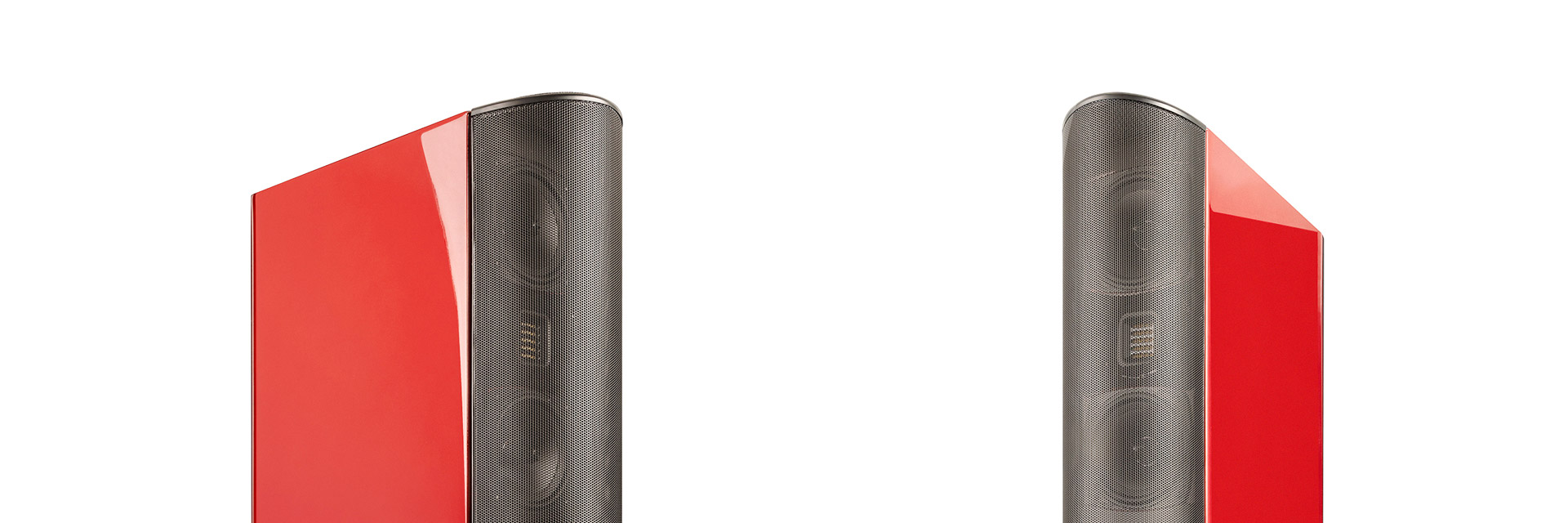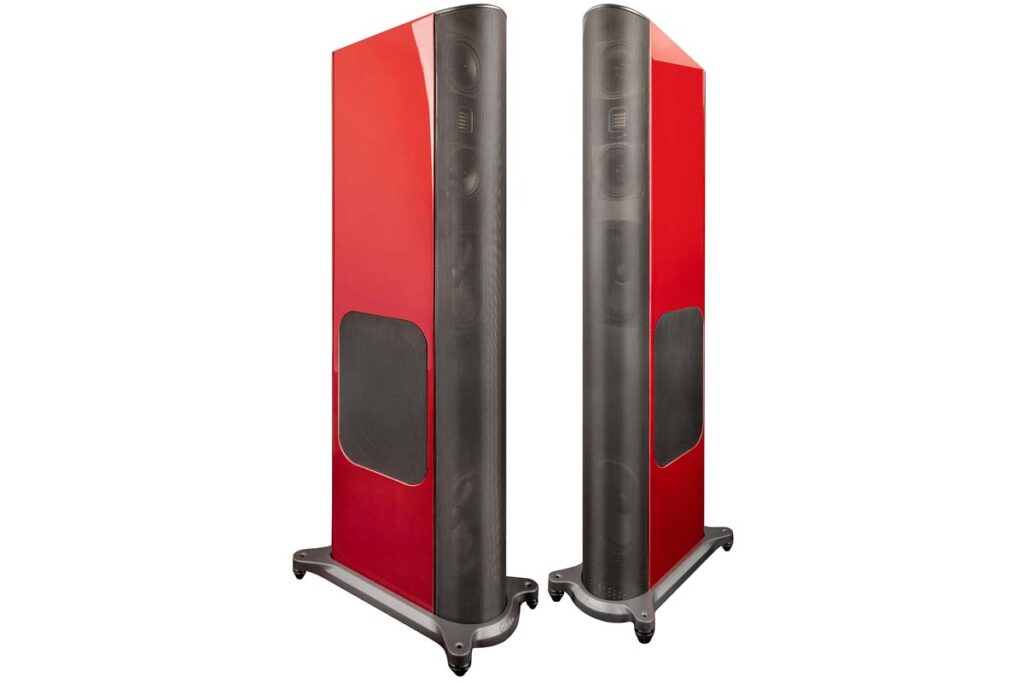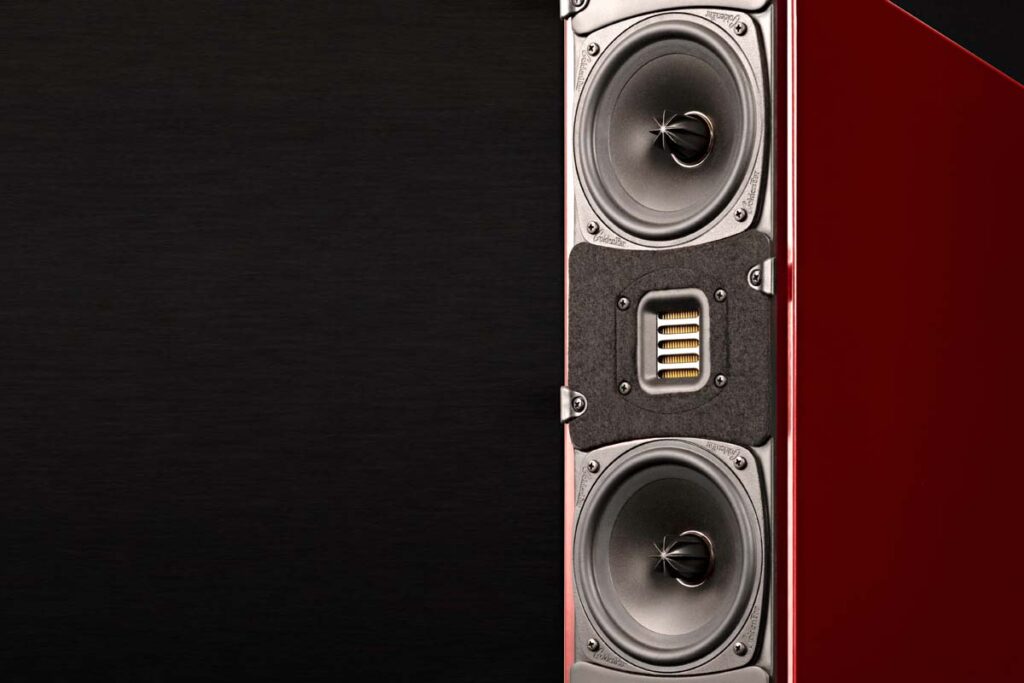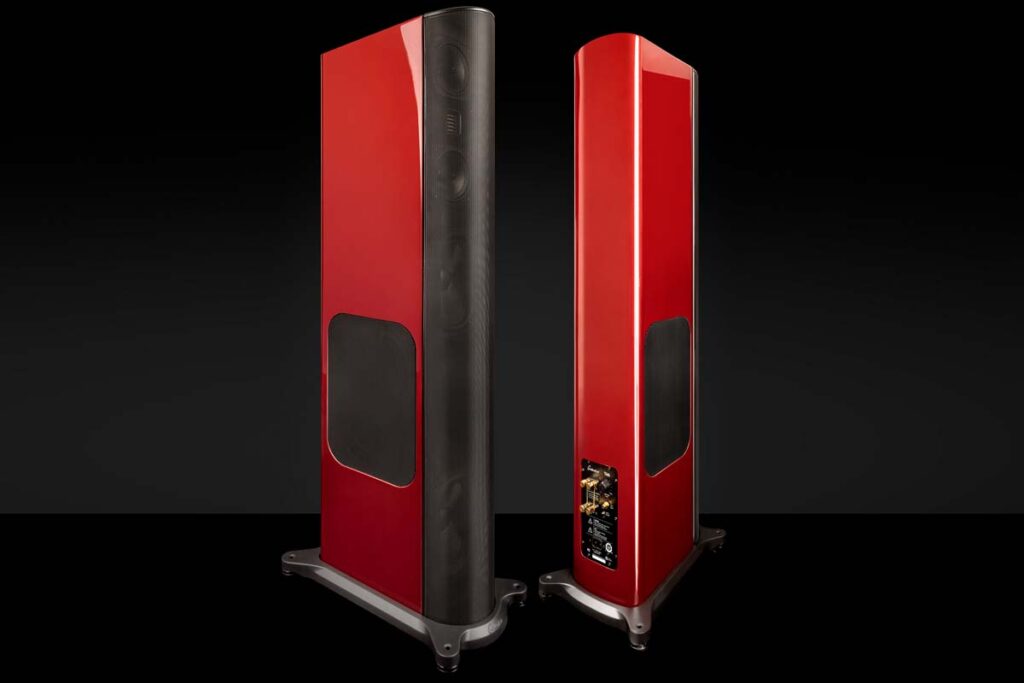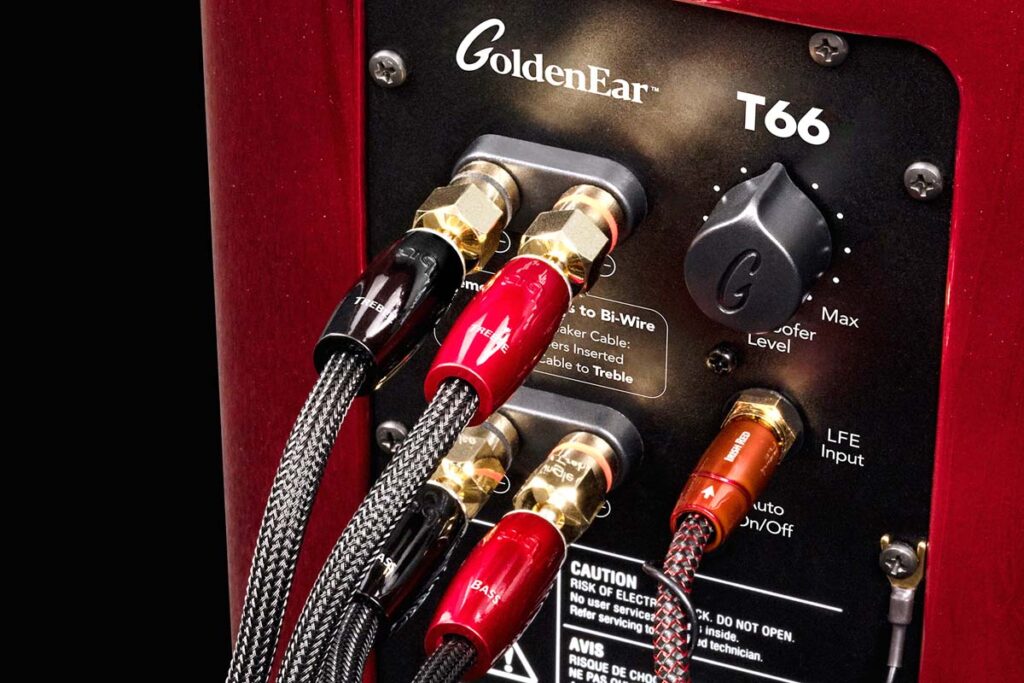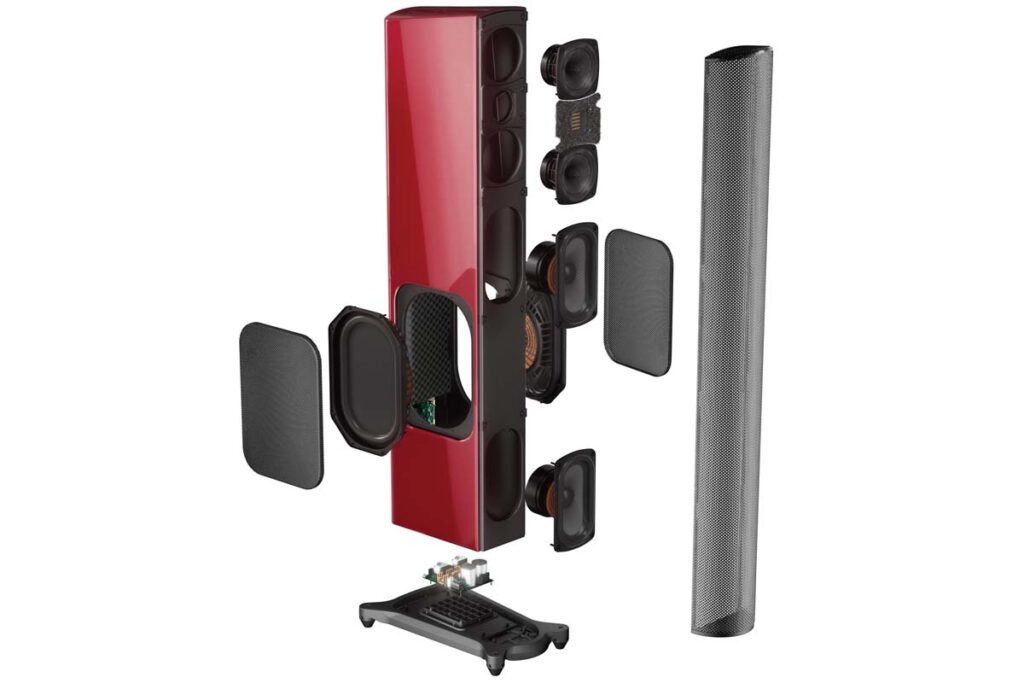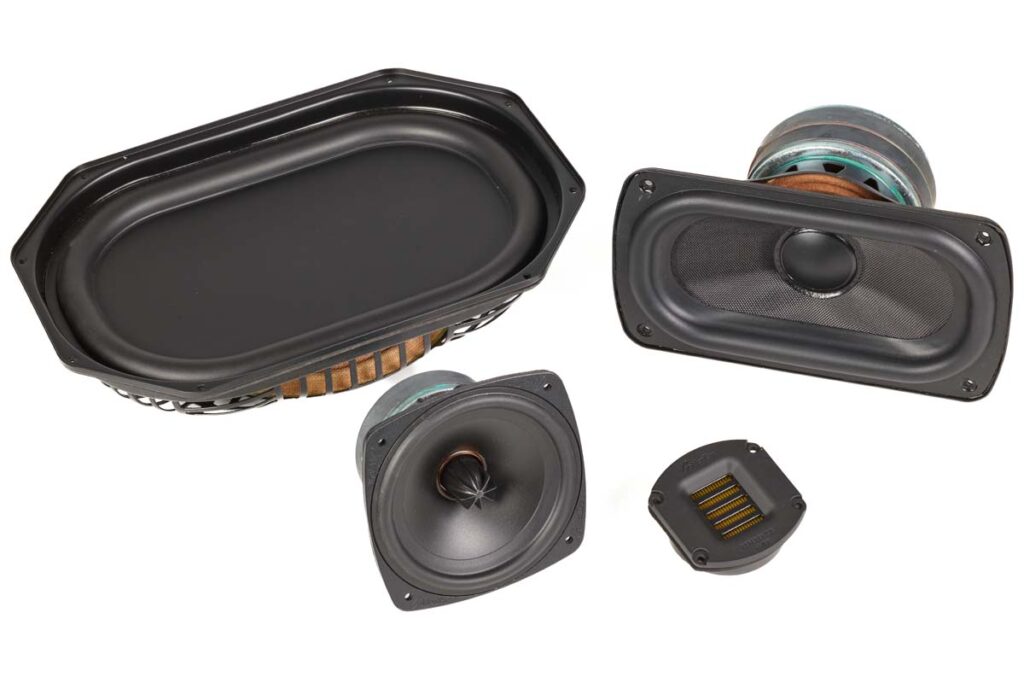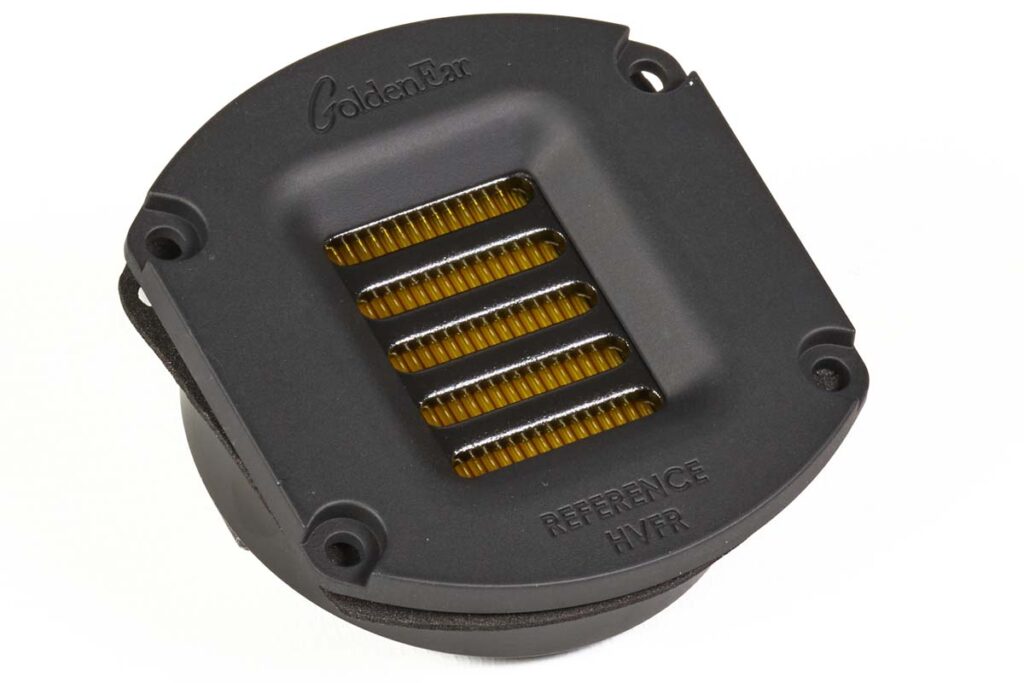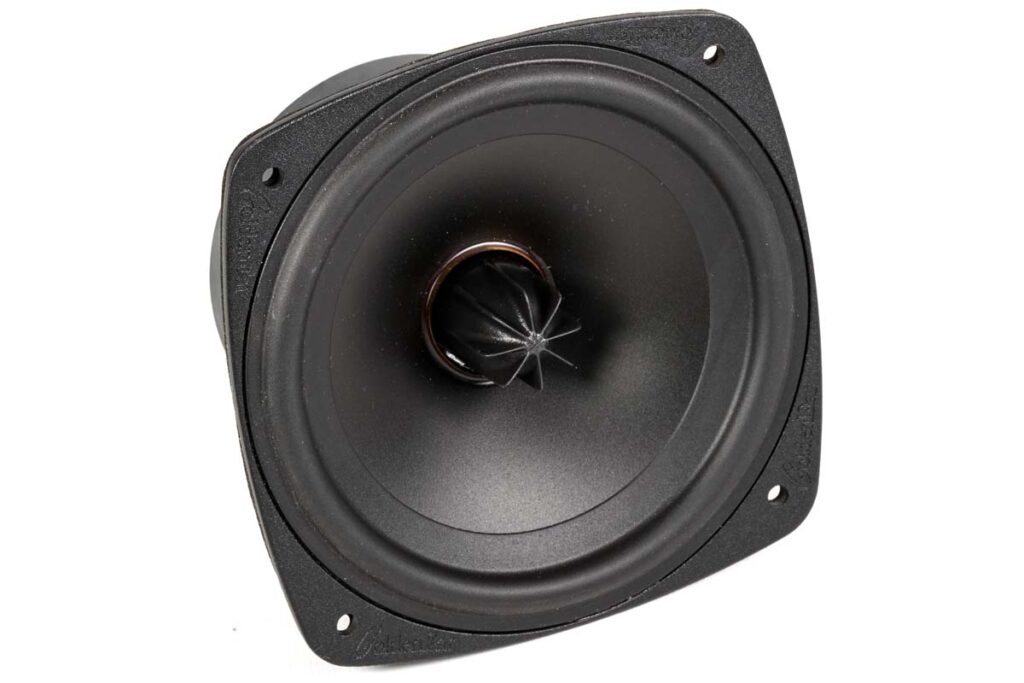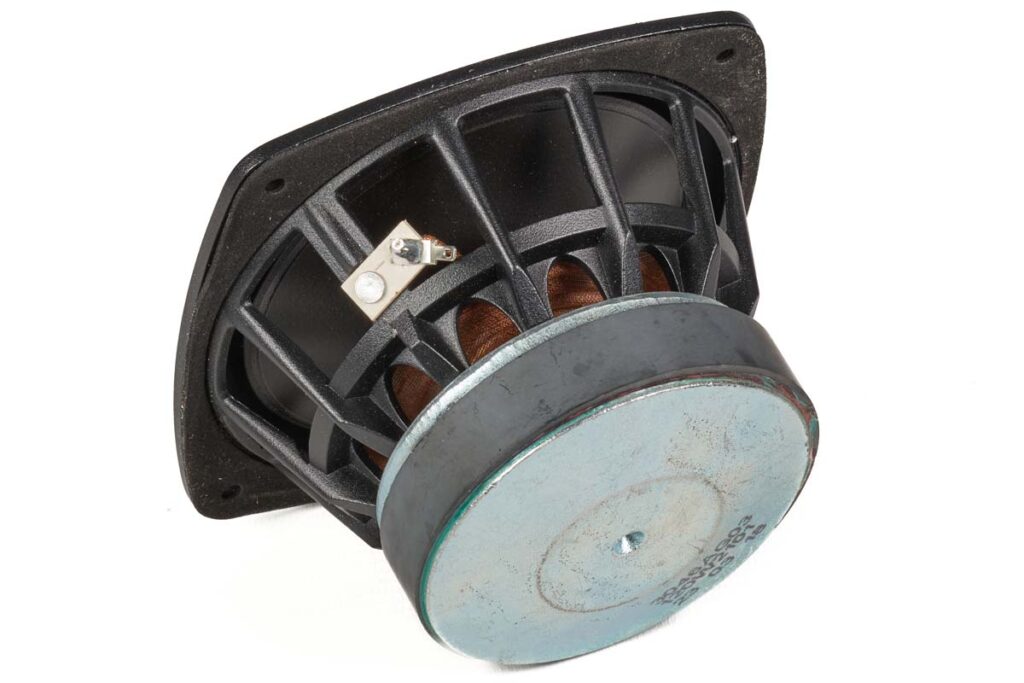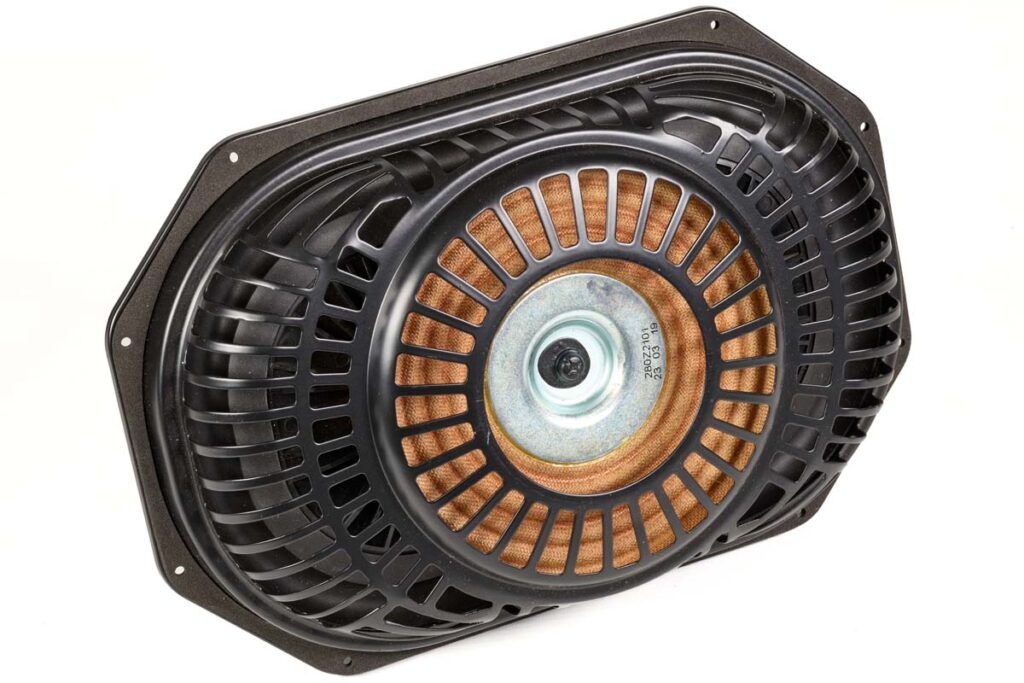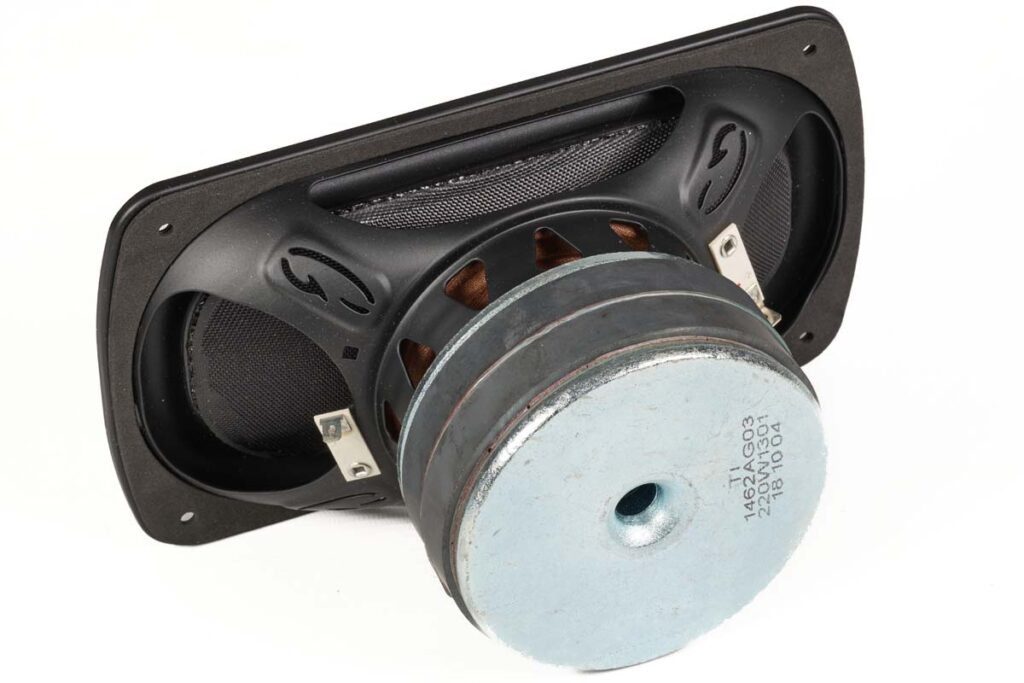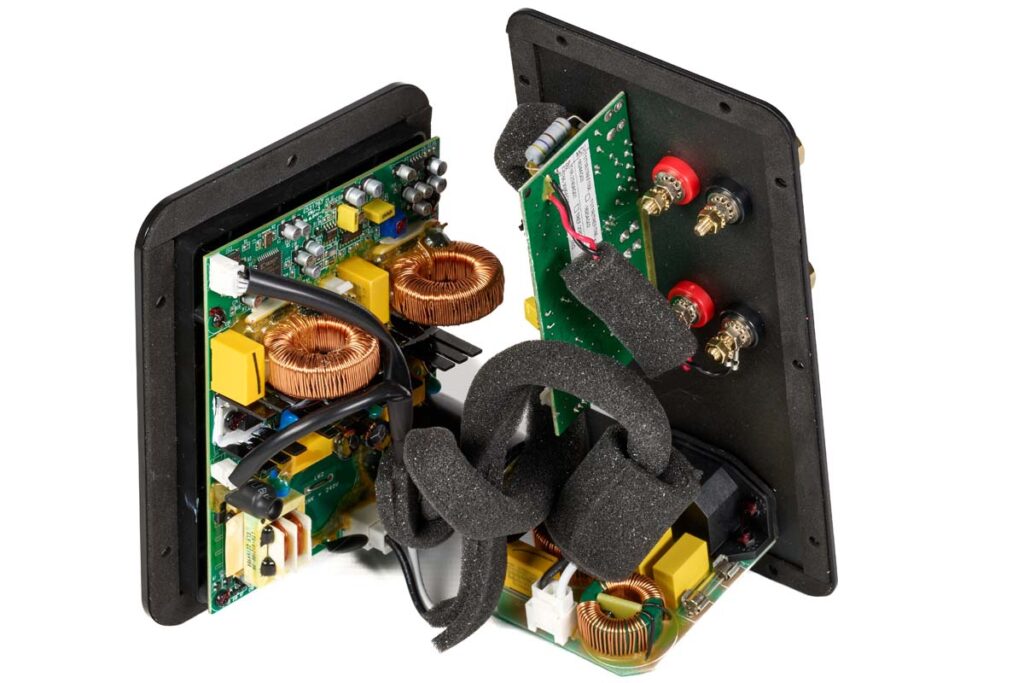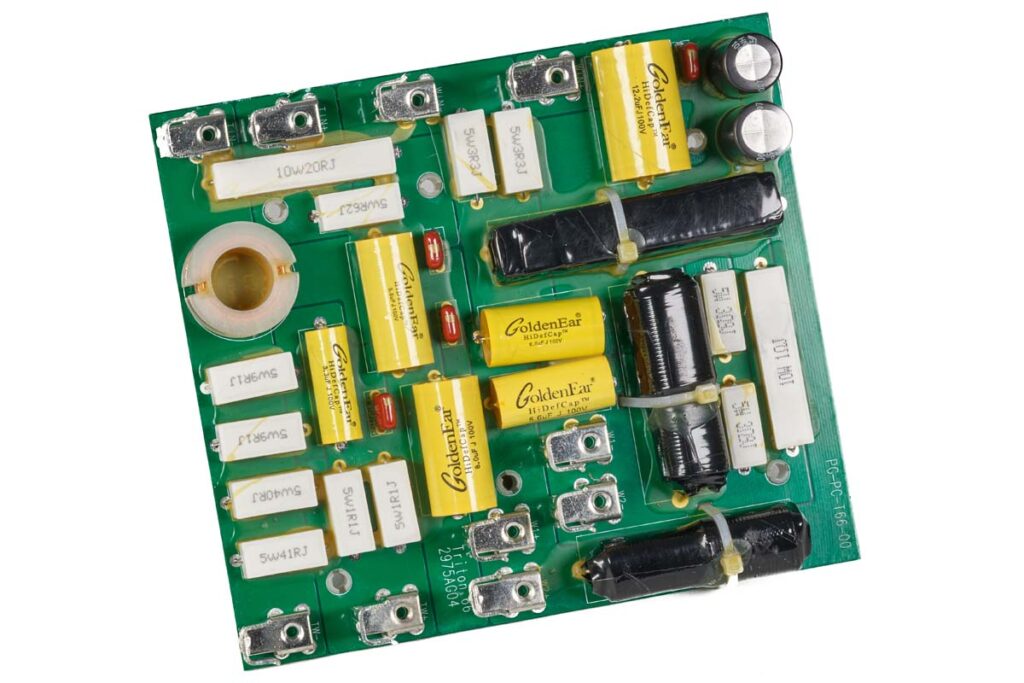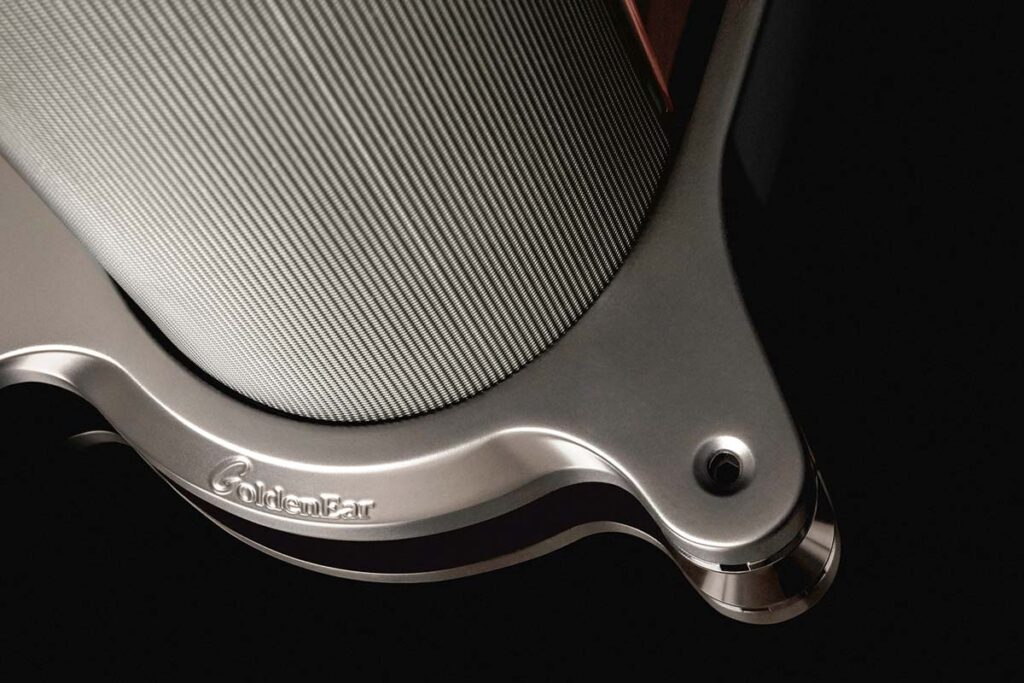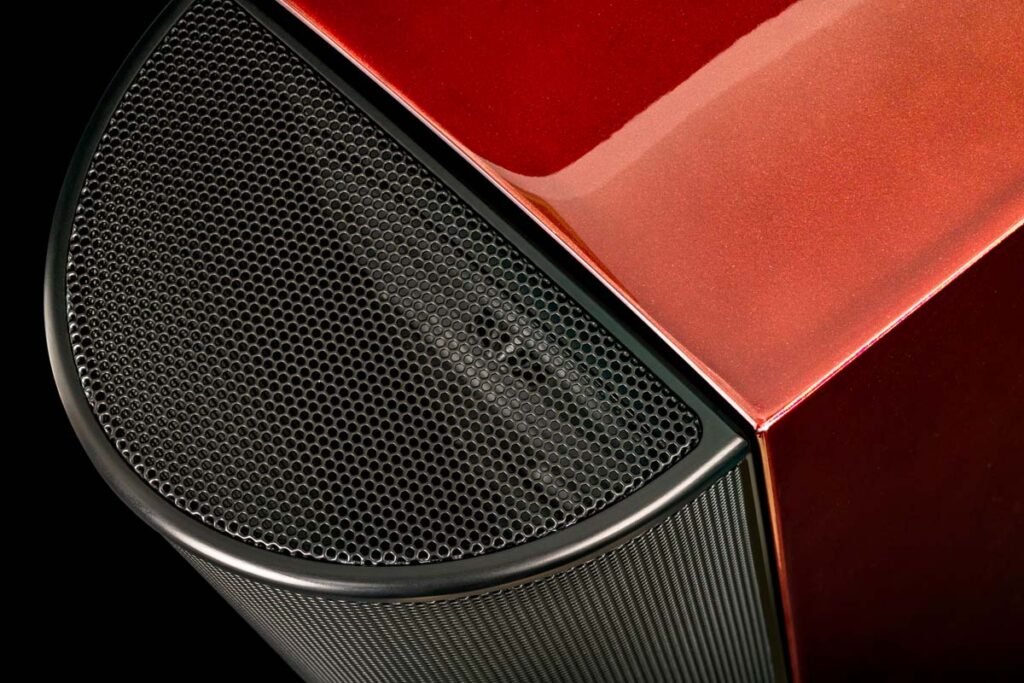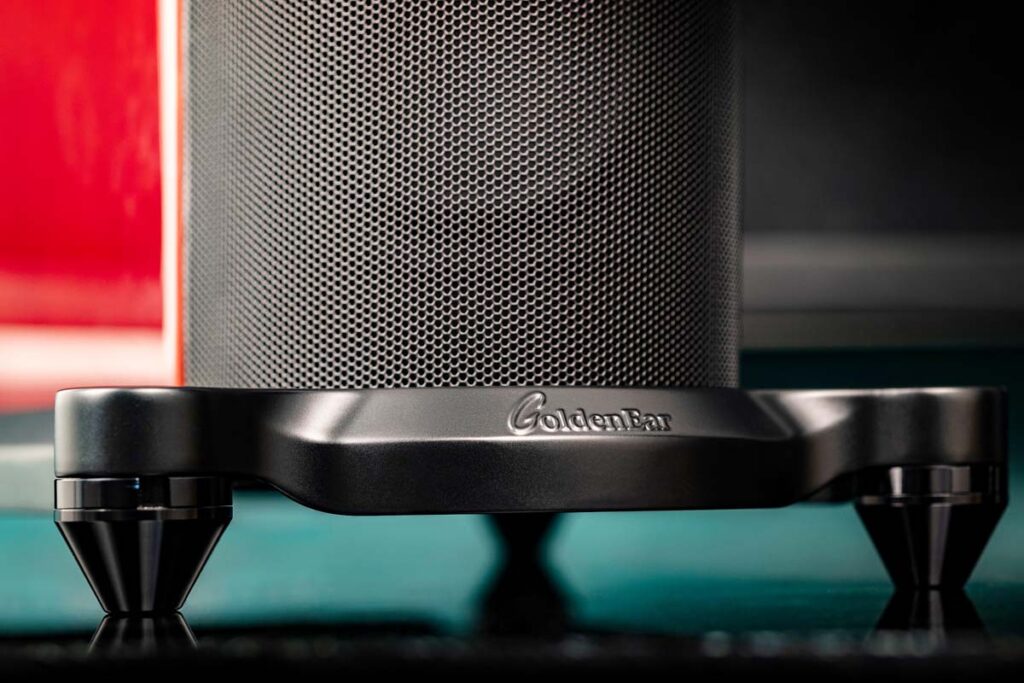Take a look at GoldenEar’s new T series next to its predecessors, and the image of a chrysalis and a butterfly comes to mind. No question: optically the new T66 makes quite the impression. But does it also reach new heights acoustically? And perhaps more crucially, does it stay true to its GoldenEar self?
It’s amazing how similar and yet fundamentally different two speakers can look. As an object of comparison to the new GoldenEar T66, we still have the Triton Three+ in our listening room, a model from the predecessor series, albeit one step below. Both share the striking silhouette with the cabinet tapering towards the front, which ends in the characteristic semi-circular baffle – and yet the effect is completely different: Where the Triton deliberately indulged in non-design with its fabric cover enshrouding the speaker almost completely, the T66 is a real eye-catcher with its high-gloss lacquer, much more elaborate all-metal base construction and drivers displayed behind a black metal hexagonal grille.
The change of course in design philosophy doesn’t come out of the blue – the new T-Series is the first GoldenEar speaker family to be developed entirely under the direction of AudioQuest. However, the basic design philosophy and, above all, the “mission” behind the series remains unchanged: Like its predecessors, the T66 aims to make a high level of sound quality accessible to normal consumers who do not primarily listen to jazz or classical music and accordingly need a speaker that graciously squints an eye when confronted with mediocre studio quality, but at the same time offers sonic performance that, right from the first bars, makes it abundantly clear to any listener that a soundbar is not the end of the line.
Not an easy balancing act to master, but GoldenEar has already shown a more than competent hand in this respect in the past. The Americans know better than almost any other manufacturer how to wrap up high-quality music playback in an uncomplicated package. One of the reasons they are able to pull this off is the fact that they have means at their disposal that most other manufacturers don’t have access to – above all, they use drivers developed and manufactured in-house rather than OEM ones. The advantage here lies not so much in the sound quality – SEAS, ScanSpeak and the like enjoy their good reputation for a reason – but rather in the flexibility with regard to the form factor: GoldenEar places particular emphasis on a design that is not visually obtrusive, and this is much easier to achieve with unconventional diaphragm shapes. Specifically, the oval bass drivers, which are almost twice as tall as they are wide, combined with generously dimensioned, almost rectangular passive diaphragms ensure that the speakers can move a lot of air in the bass range despite their strikingly slim profile.
Change of Wardrobe
The previous, fully fabric-covered design is actually a perfect fit for this sonic stealth approach. With the new T66, however, AudioQuest has, as mentioned at the beginning, opted for a change of direction. The reason for this is the simple realization that soundbar design aesthetics just won’t do for a product at a mid-four-digit price point. In the end, they opted for the best of both worlds and sacrificed some of the unobtrusiveness on the altar of a much higher quality fit and finish. In addition to the striking mesh grille and the beautiful lacquer finish, especially in the Santa Barbara Red version, this is reflected in a much more complex foot construction than before. The all-aluminum base now features spikes that can be easily adjusted from above using an Allen key, including a counter ring that can be operated with the bare hand. Thankfully, parquet flooring enthusiasts can do without pucks, as rubber feet are also included as an alternative to the rigid coupling. The well-judged form factor has been retained, however, meaning that just like before, it capitalizes on the manufacturer’s capacity to tailor the driver shape to the desired cabinet design and not the other way around.
Fine-tuning on the inside
The acoustics have also been tweaked and optimized. Midrange and treble still come courtesy of the tried-and-tested combination of the AMT tweeter and two of the familiar 12-centimeter midrange drivers with their characteristically shaped diffraction plugs. The developers have also toyed with the positioning of the bass drivers. The two drivers now sit at some distance from each other on the baffle: one directly under the MTM array, the other has been moved to the bottom. The laterally arranged passive diaphragms sit halfway between the active drivers. This arrangement is intended to ensure that the radiators are stimulated more evenly by the low frequency portion of the back wave, resulting in greater efficiency and thus higher sound pressure levels.
The crossover has also been thoroughly reworked, with considerable effort put into achieving a more open, transparent sound. The developers have added a small, high-quality bypass capacitor to the cap in the treble section – a popular and surprisingly effective trick that can significantly improve the sound without too much additional cost. On the other hand, the Zobel impedance correction network used previously to make the speaker easier to drive has been omitted because, according to Robert Hay from AudioQuest, the increased component count in the crossover noticeably sucked the life out of the sound character.
Speaking of “easy to drive”: As before, the amplifier only has to drive the mid-high section, while the bass is powered by an internal, DSP-controlled Class D power amplifier that can deliver a whopping 500 watts RMS. Even though the T66 is a nominal 4-ohm load, the sensitivity of 91 decibels (2.83 V/1 m) is decently high, especially considering the modest cabinet volume. Hay therefore has no qualms recommending inexpensive AV receivers to drive these.
It does take a little effort
The one thing that stands in the way of uncomplicated listening pleasure, at least initially, is positioning: the slim columns are surprisingly demanding in this regard. The simple plonk-and-play approach works reasonably well, but you’ll immediately realize that there is still room for improvement. They throw a fairly large stage right out of the gate, but there is a lack of clarity in the positioning of individual sonic events. I also initially placed them in a rather free-standing position, which resulted in a somewhat meagre low end that couldn’t really be remedied by turning the volume knob on the integrated subwoofers. The distance to the rear and side walls, and even more so the toe-in, have a greater effect on tonal balance and soundstaging than with most other speakers I’ve heard.
The T66 generally prefer to be positioned relatively close to the wall, but if the distance to the side walls is too short, the AMTs will quickly punish this with unpleasant comb filter effects. Conveniently, though, they readily communicate when they are positioned correctly: Set up close to the back wall and spaced not too far apart, plus toed in such that they are pointed at my shoulders, the soundstage positively snaps into place: ‘Sandman’ by America from their debut album of the same name begins with Dewey Bunnell’s thin voice and a guitar, which is joined by a second one after a few bars. Whereas before, everything seemed to float across the room, somewhat uncertain and searching, the GoldenEars now lock all the actors in place without the slightest ambiguity. Bunnell’s voice comes across beautifully free of slag, while the two guitar bodies bring the right amount of fundamental warmth to the action. The subwoofer level is exactly in the middle – “now”, the US-speakers make it unmistakably clear to me, “we feel right at home”. And they immediately reward me with a liveliness and immediacy of attack that I wasn’t quite prepared for. The piece begins slowly and melancholy, but then progressively picks up the pace – and the T66 are a joy to listen to here.
Using Youn Sun Nah’s “The Wonder” (Immersion) as a starting point, I commence a close examination of the active bass section. Drums, distorted piano and synthesizer provide low frequency elements that start and stop on a dime, demanding authority and control in equal measure. The GoldenEar T66s leave nothing to chance here and show significantly more lung volume than I would have given them credit for: powerful bass from small enclosures typically tends to sound somewhat dense and compressed – here I can hear no trace of these effects: they push the impulses confidently into the room and zip it up again in a flash when required without any resonance.
The new T series isn’t quite as care-free as the Triton speakers – but take a little time to properly set them up and they’ll show themselves to be as unpretentious as ever: they will pair well with almost any amplifier, regardless of whether transistors or tubes provide the power – only the most delicate amps with single-digit output power will be out of their depth. In good GoldenEar fashion, the T66s are equally unfussy about music selection: Tonality and fine detail retrieval leave no questions open with audiophile fare such as the aforementioned Youn Sun Nah. At the same time, however, the AMT’ manners have been cultivated so effectively that even the Smashing Pumpkins never become fatiguing. And the fact that they are visually more striking than before doesn’t bother me in the slightest – if you look this good, you have a right to stand out.
Accompanying Equipment
CD player: Ayon CD-3sx, Audio Note CD 3.1x, Accuphase DP-570 | Network player/DAC: Lumin X1, Soulnote D-3, Aavik S-580 | Turntable: AVM Rotation R5. 3 MK2 | Integrated amplifier: Aavik I-580, Line Magnetic LM-88IA | Preamplifier: Accuphase C-2300, Phasemation CM-2200 | Power amplifier: Burmester 216, Accuphase P-7500 | Speakers: Wilson Audio Sasha DAW, Audio GE Teddy | Rack: Solidsteel, Finite Elemente, Creaktiv | Cables: AudioQuest, HMS, in-akustik
Loudspeakers GoldenEar T66
Concept: semi-active 3-way loudspeaker with passive radiators | Driver complement: 1 x HVFR (High Velocity Folded Ribbon) tweeter, 2 x 4.5“ midrange cone, 2 x 5/9” woofers, 2 x 6.75/8” passive cone | Subwoofer output: 500 W RMS per channel (1000 W peak) | Inputs: bi-wire speaker terminal, LFE, power connection for subwoofer | Nominal impedance: 4 Ω | Sensitivity: 91 dB | Frequency response: 29 Hz to 25 kHz | Recommended amplifier power: 20 to 500 W per channel | Dimensions (W/H/D): 19/124/37.5 cm (height on stand without spikes), stand 30/43 cm (W/D) | Weight: 27.2 kg | Warranty period: 2 years | Pair price: around € 7000; Santa Barbara Red version € 7300
AudioQuest
Hoge Bergen 10
4704 RH Roosendaal
Netherlands
Phone +31 165 541404

